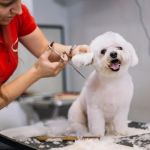
- 1- Introduction
- 2- Understanding Shy Pets
- 3- Effective Strategies for Building Confidence
- 4- Creating a Positive Environment for Your Pet
- 5- Monitoring Progress and Adjusting Approaches
1. Introduction
Many pets, especially those who may have had traumatic past experiences or were not properly socialized, can struggle with shyness. If your pet is naturally reserved, it's essential to help them build confidence so they can enjoy a more active and fulfilled life. Shy pets may exhibit behaviors such as hiding, avoiding eye contact, or being fearful of new situations and people.
Building confidence in a shy pet takes time and patience, but with the right techniques, you can help your pet overcome their anxiety. In this article, we’ll explore the best strategies for building confidence in shy pets, with tips to help them feel secure and more comfortable in their environment.
2. Understanding Shy Pets
Before you can help your pet build confidence, it's essential to understand why they are shy in the first place. Shyness in pets can stem from various causes:
- Past Trauma or Abuse: Pets that have experienced neglect, abuse, or fear-based experiences may be more prone to shyness. Their behavior may be a protective mechanism to avoid potential harm.
- Limited Socialization: Pets that haven't been exposed to different environments, people, or other animals during their formative months may be more cautious and reserved.
- Personality: Some pets are naturally more reserved or independent, and shyness may simply be part of their personality.
- Health Issues: Shyness can also be a symptom of underlying health problems, such as pain or discomfort, which can make pets more withdrawn or fearful.
Understanding the root causes of your pet's shyness will allow you to tailor your approach to their unique needs, which is essential for building trust and confidence.

Kona Reef Az - Surprise
SurpriseMaricopa CountyArizona
12301 W Bell Rd Ste A107, Surprise, AZ 85378, USA
3. Effective Strategies for Building Confidence
Building confidence in a shy pet requires patience and consistency. Here are some effective strategies to help your pet feel more secure and comfortable:
- Start Slow and Gradual Exposure: Begin by slowly introducing your pet to new experiences or people. Don’t overwhelm them with too many changes at once. Gradual exposure to different situations helps your pet build familiarity and comfort over time.
- Use Positive Reinforcement: Reward your pet with treats, praise, and affection when they show courage or approach new situations. Positive reinforcement builds a strong connection between bravery and rewards, which motivates your pet to engage more confidently.
- Consistent Routine: Pets thrive on routine. Having a predictable daily routine helps your pet feel secure and confident in their environment, reducing the anxiety that can lead to shyness.
- Offer Safe Spaces: Ensure your pet has a quiet, comfortable space where they can retreat to when they feel overwhelmed. Having a safe zone allows them to retreat when needed, helping them feel more secure overall.
- Socialization with Other Animals and People: Introducing your pet to other friendly animals and people in a controlled manner can improve their social confidence. Always ensure the interactions are calm and positive.
Remember, every pet is unique, and some may need more time than others to adapt. The key is to be patient, persistent, and consistent in your efforts.
4. Creating a Positive Environment for Your Pet
In addition to using specific strategies to help your pet gain confidence, creating an overall positive environment plays a significant role in boosting their self-esteem. Here are a few tips to enhance your pet's environment:
- Minimize Stressors: Identify any potential stressors in your pet’s environment, such as loud noises, other aggressive pets, or chaotic surroundings. Try to minimize these as much as possible to create a calming space.
- Provide Mental Stimulation: Keeping your pet mentally engaged with puzzle toys, games, or training can help them build confidence as they master new tasks. This also provides a sense of accomplishment and reduces anxiety.
- Physical Exercise: Regular exercise is vital for your pet’s mental and physical well-being. Exercise releases endorphins, which help reduce stress and promote a sense of calm, helping to build confidence.
By fostering a peaceful and nurturing environment, you create a foundation for your pet to feel safe, secure, and confident as they explore new things.
5. Monitoring Progress and Adjusting Approaches
As you work to build confidence in your shy pet, it’s important to monitor their progress and adjust your approach as needed. Not all pets respond to the same methods, so it’s essential to be flexible and adaptable:
- Keep Track of Behavior: Note changes in your pet's behavior, such as increased exploration, interaction, or reduced anxiety. These positive signs indicate progress and should be celebrated!
- Adjust the Pace: If your pet seems overwhelmed, slow down the pace of exposure or training. Allow them to adjust at their own rate to avoid causing setbacks.
- Consult a Professional: If your pet’s shyness is severe or doesn’t improve with your efforts, consider seeking advice from a professional pet behaviorist or trainer who specializes in shy or anxious pets.
Building confidence takes time, but with consistent care and effort, your shy pet will gradually become more confident in their surroundings. The bond you share with your pet will grow stronger, and they’ll enjoy a more fulfilling and active life.
If you need further help with your pet’s behavioral needs or finding the right pet care products, visit Pet & Puppy for expert advice and recommendations.








 Lovet Pet Health Care - Westbrook4.0 (746 reviews)
Lovet Pet Health Care - Westbrook4.0 (746 reviews) Animal Hospital of Laveen4.0 (537 reviews)
Animal Hospital of Laveen4.0 (537 reviews) VIP Petcare Vaccination Clinic0.0 (0 reviews)
VIP Petcare Vaccination Clinic0.0 (0 reviews) Dr. Tamantha S. Hickok4.0 (25 reviews)
Dr. Tamantha S. Hickok4.0 (25 reviews) Dr. Julia Stricker Esposito, D.V.M4.0 (35 reviews)
Dr. Julia Stricker Esposito, D.V.M4.0 (35 reviews) Spay Neuter Clinic: Chandler4.0 (734 reviews)
Spay Neuter Clinic: Chandler4.0 (734 reviews) How to Handle Pet Loss: Grieving, Supports & Memorial Ideas for Pet Owners
How to Handle Pet Loss: Grieving, Supports & Memorial Ideas for Pet Owners Best Practices for Pet Grooming Frequency by Breed: Keeping Your Pet’s Coat Healthy
Best Practices for Pet Grooming Frequency by Breed: Keeping Your Pet’s Coat Healthy Pet Vaccination Schedule: Essential Shots Your Pet Needs to Stay Healthy
Pet Vaccination Schedule: Essential Shots Your Pet Needs to Stay Healthy How 3D Printing Is Being Used in Pet Prosthetics & Surgery | Pet & Puppy
How 3D Printing Is Being Used in Pet Prosthetics & Surgery | Pet & Puppy How to Build a Pet Emergency Kit: Essentials You Need
How to Build a Pet Emergency Kit: Essentials You Need How Often Should You Change Your Pet’s Diet? A Vet’s View
How Often Should You Change Your Pet’s Diet? A Vet’s View